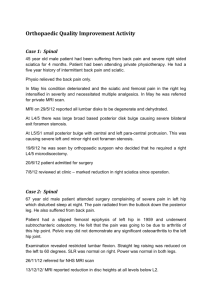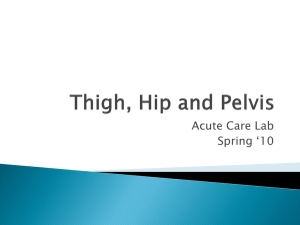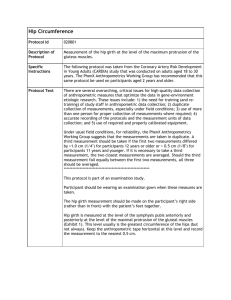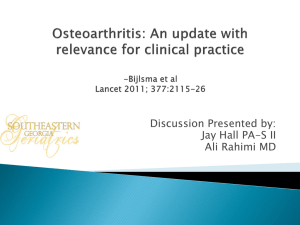MS 3 review
advertisement
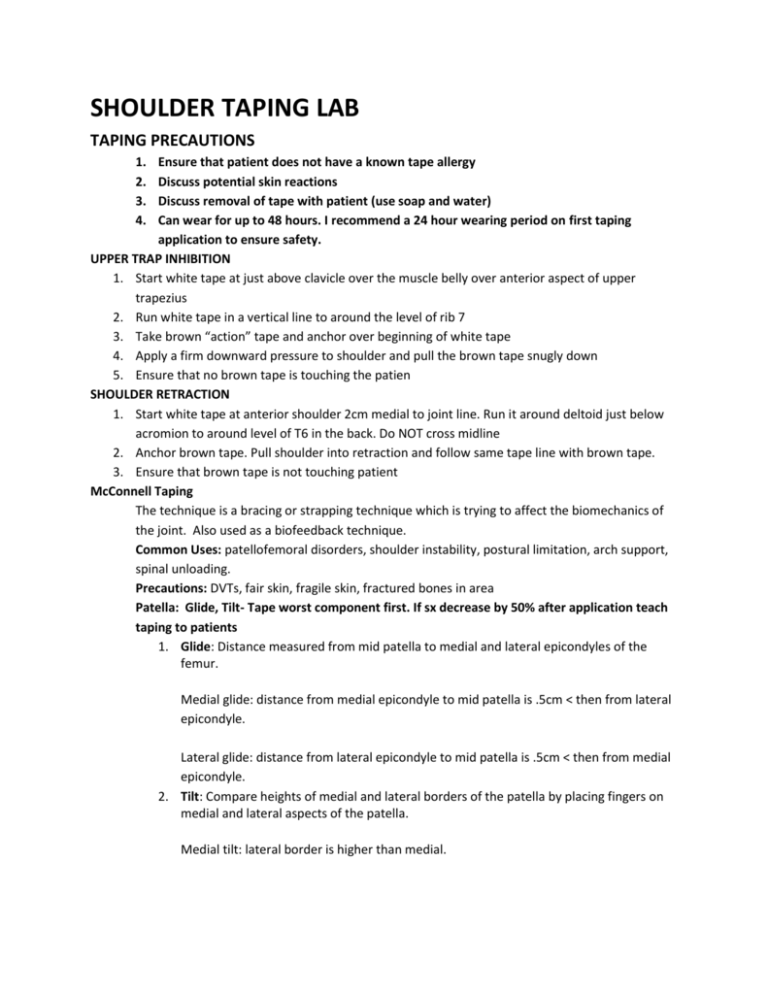
SHOULDER TAPING LAB TAPING PRECAUTIONS 1. 2. 3. 4. Ensure that patient does not have a known tape allergy Discuss potential skin reactions Discuss removal of tape with patient (use soap and water) Can wear for up to 48 hours. I recommend a 24 hour wearing period on first taping application to ensure safety. UPPER TRAP INHIBITION 1. Start white tape at just above clavicle over the muscle belly over anterior aspect of upper trapezius 2. Run white tape in a vertical line to around the level of rib 7 3. Take brown “action” tape and anchor over beginning of white tape 4. Apply a firm downward pressure to shoulder and pull the brown tape snugly down 5. Ensure that no brown tape is touching the patien SHOULDER RETRACTION 1. Start white tape at anterior shoulder 2cm medial to joint line. Run it around deltoid just below acromion to around level of T6 in the back. Do NOT cross midline 2. Anchor brown tape. Pull shoulder into retraction and follow same tape line with brown tape. 3. Ensure that brown tape is not touching patient McConnell Taping The technique is a bracing or strapping technique which is trying to affect the biomechanics of the joint. Also used as a biofeedback technique. Common Uses: patellofemoral disorders, shoulder instability, postural limitation, arch support, spinal unloading. Precautions: DVTs, fair skin, fragile skin, fractured bones in area Patella: Glide, Tilt- Tape worst component first. If sx decrease by 50% after application teach taping to patients 1. Glide: Distance measured from mid patella to medial and lateral epicondyles of the femur. Medial glide: distance from medial epicondyle to mid patella is .5cm < then from lateral epicondyle. Lateral glide: distance from lateral epicondyle to mid patella is .5cm < then from medial epicondyle. 2. Tilt: Compare heights of medial and lateral borders of the patella by placing fingers on medial and lateral aspects of the patella. Medial tilt: lateral border is higher than medial. Lateral tilt: medial border is higher than lateral.- Runners that have tight IT bands, VL is bigger and stronger will actually pull the patella more laterally Should be able to feel the superior and inferior poles of the patella. Inferior Tilt is common for post surgical pts. Kinesiotaping- can be left on up to 2-3 days and can be used in areas of known fracture Cutting the tape will dissipate the force Therapeutic effect- lies in the recoil of the tape a. Normalize muscle function ( inhibit or facilitate ) a. Inhibit: Tape distal to proximal or insertion to origin, 15%-25% tension i. Overuse / inflammation : Achilles Tendonitis 1. Anchor at heel (i) gently pull up to muscle belly (o) bc recoil will be going down b. Facilitate / Support: Tape proximal to distal or origin to insertion, 25-50% tension. i. Weak muscle: Quads 1. Anchor at quad belly (o) and gently pull and attach on patella tendon (i) b. Improve lymphatic and blood flow a. Lymphatic: i. Proximal to distal, 25% tension c. Reduce pain- pain inhibits contraction d. Correct joint mal-alignment and improve proprioception e. Scar management Knee Noncontact injury with “pop”: ACL tear Contact injury with “pop”: MCL or LCL tear, meniscus tear, fracture Acute swelling: ACL tear, fracture, knee dislocation Lateral blow to the knee: MCL tear Medial blow to the knee: LCL tear Knee “gave out” or “buckled”: ACL tear, patellar dislocation Fall onto a flexed knee: PCL tear Medial Knee: MCL, Pes Anserine, Bursa Valgus Stress Test performed at 0-5 and 20 deg ext tests MCL Structures Injured at FULL EXT if positive Structures Injured at 20 DEG EXT if positive 1. MCL 1. MCL 2. Posterior oblique ligament 2. Posterior oblique ligament 3. Posteromedial capsule 3. PCL 4. ACL 5. PCL 6. Medial quadriceps expansion 7. Semimembranosus muscle Lateral Knee- LCL, fibular head, hamstring, lateral patellar retinaculum Varus stress test performed at 0-5 deg ext and 20 deg ext tests LCL Structures Injured at FULL EXT if positive Structures Injured at 20 DEG EXT if positive 1. LCL 1. LCL 2. Posterolateral capsule 2. Posterolateral capsule 3. Arcuate-popliteus complex 3. Arcuate-popliteus complex 4. Biceps femoris tendon 4. ITB 5. ACL 5. Biceps femoris tendon 6. PCL 7. Lateral gastrocnemius PCL Injury Posterior drawer test, Positive posterior sag test- Hooklying and 90/90 (Godfrey’s test), Dash board injury, Direct blow to anterior knee, Fall on a flexed knee ACL Injury Incidence: Athletes greater than non-athletes, Women more than men - 2-10x higher , greater Q-angle, Hormonal, Strength ratio and activation patterns quad/ham ,Ages 15-25 MOI- deceleration injury- slowing down, changing direction that creates valgus stress or injury most are non-contact, pivot or twist, landing or cutting, knee hyperextension- more than hyperflexion, valgus force at the knee during sports Tests Lachman’s, Pivot-shift test, knee arthrometer Rehab Phase I: 0-1 week • Control edema • ROM to 90 • Crutches • Patellar mobs • SLR, Isometrics • Heel slides • Extension hang • Weight shift Phase III: 9-16 wks • Expect to reach full ROM • Plyometrics • Jogging: wk 13 • Dynamic balance • Jumping/hopping Phase II: 2-9 wks • Control pain/edema • Patellar mobs • Mini-squats • Step ups • SLS Phase IV: 16-22 wks • Agility exercises • Shuttle run • Carioca • Sport specific exercise Meniscal injuries most common in posterior horn, locking or giving way most common in 40s Tests McMurray’s, Apley’s- compression and distraction, joint line pain, Ege’s, Thessaly’s Considerations Flexion angles >60, weight bearing ex, good quad control needed Patellofemoral Anterior knee pain, chondromalacia- general knee pain, tracking problem (PF)general knee pain, subluxation, dislocation, fracture Testspatellar apprehension, J-sign, glide and tilt, Clarke’s Test RehabilitationNon-surgical, sometimes release is performed, add step ups, squats, bike when appropriate, restore flexibility somewhere else: ITB, address mm weakness, analyze running pattern,taping and bracing options Isolated Ligament Injury Rehab Aggressive non-operative rehab, hinged brace worn 3-4 week, possible crutches for 1 week, push ROM: bike, electrical stimulation for mm activation as needed, Begin to strengthen with light resistance, limit squats to 30 degrees, aerobic activity, step ups, finally progression to function pivot and cutting Open chain exercises are not recommended due to the excessive anterior translation of the tibia on the femur during extension. Return to Sport CriteriaHop test: different versions- straight forward, side to side and timed hops, percentage strength compared to other side, KT-1000 HIP Hip OA SX- hip/groin pain that can radiate to the greater trochanter, pain after sitting, pain with weight bearing, MORNING STIFFNESS, limited in flexion and IR CPR for Hip Diagnosis: ▫ Self reported squatting as aggravating factor ▫ Active hip flexion causes lateral hip pain ▫ Scour test with adduction causes lateral hip/groin pain ▫ Pain with active hip extension ▫ Passive hip IR <25 degrees Non surgical Tx- Weight control- educate on options, refer to nutritional counselor, shoe wear, use of assistive device (cane), modalities, maintain full hip ROM, strengthening exercises, manual therapy- ant glide, mob with belt, keep moving-but in an appropriate way THR Anterior Approach PROS: No hip precautions, able to weight bear more quickly within 12 weeks, 4-5 inch incision rather then 10-12- have more incisional pain, no muscular detachment CONS: requires specific table for surgery-VERY EXPENSIVE, increased surgeon skill, surgery procedure lasts longer Snapping Hip Syndrome INTERNAL: Iliopsoas snaps over structures deep to it: femoral head, lesser trochanter, AIIS, iliopectineal eminence, pectineus fascia OR tenosynovitis of iliopsoas insertion EXTERNAL: Snapping of ITB or glut max over greater trochanter, affects females > males INTRAARTICULAR: Loose bodies, labral tears, snapping of iliofemoral ligament over anterior femoral head Femoral Acetabular Impingement (FAI) Ball and socket rub abnormally leading to deficits in either the articular or labral cartilage Cam more common in men : femoral head loss of roundness Pincer more common in females: acetabulum overcoverage Legg- Calve-Perthes Symptoms: insidious onset, Limp with outtoe, leg drag and trendelenberg gait, ache in groin radiating to medial thigh or inner knee, muscle spasm, limited abduction and IR, may have hip flexion and adduction contracture Intervention: Observation ,bracing, surgical SCFE MOST COMMON hip condition in adolescents -anterior displacement of femoral neck from capital femoral epiphysis while head remains in acetabulum SYMPTOMS: Groin or medial thigh pain, knee or lower thigh pain, ROM < IR, flex, abduction, mild weakness INTERVENTION: surgery Systemic Causes of HIP and GROIN pain: Cancer Hip pain can occur from spinal metastasis to femur or lower pelvis o Bone tumors causing hip pain: o Chondroblastoma o Chondrosarcoma o Giant Cell tumors o Ewing’s sarcoma Osteoid Ostoma Small benign tumor-painful o Occurs in often teenagers (ages 4-25 affected) o Affects males 3x more often then females o Symptoms: dull, chronic hip/knee/thigh pain, antalgic gait, tenderness, hip ROM limitations o Worse at night o Occurs in proximal Femur and Pelvis Psoas Abcess localized collection of pus commonly in right hip o pain in medial thigh and femoral triangle. o Muscular spasm with possible hip flexion and contracture o internal rotation of hip o Fever and night sweats o GI symptoms o Causes: Abdominal/Peritoneal inflammation including diverticulitis, Crohn’s disease, appendicitis, Spinal tuberculosis (often associated with AIDS) o TREATMENT: Draining and antibiotics Hip Hemiarthrosis CAUSED BY: hemophilia o Pain in groin/thigh o Limited motion hip flex, abd, ER o Feeling of “fullness” in hip joint – feel like they can’t move o May show melena(black tarry stool) and fever (Goodman 2000) o Patient will hemorrhage into psoas muscle Ureteral Pain o Pain in groin with radiation around into lower abdomen o May have general abdominal tenderness o Nausea, vomiting and decreased intestinal mobility o May see (+) rebound tenderness Ascites: fluid collection in peritoneal cavity leading to distended abdomen Abdominal Aortic Aneuryism (AAA): Experience a “pulsating mass” in abdomen that may/may not occur with back, hip, groin, flank pain due to pressure on structures- Call 911 ANKLE Subjective Running Exam • How long have they been running? • Where do you run (TM, outside, etc.) • Workouts-# per week/mileage per workout • Warm-up, cool down, stretching done • Type of shoes worn • Type of socks and # of pairs • Date of last race/date of next race Plantar Fascitis Symptoms : Pain, especially on initial WB in AM, radiating pain up calf or to toes , imited ADLS Objective Findings: Pain along medial edge fascia or over medial calcaneal tubercle achilles tendon tightness Treatment: • • • • • • • Night splinting-limited evidence- sheets pull into PF and when you stand up will micro tear as you DF Orthotics/shoe modification Heel cups/taping NSAIDs Stretching and strengthening- big toe stretch Deep Friction massage/IASTM Home management- ice bottle massage, frozen rolling pins Sever’s Disease(Calcaneal Apophysitis) Inflammation of calcaneal apophysitis. Symptoms: Pain in heel, difficulty walking, swelling Caused by: repetitive trauma to apophysis due to the pulling of the Achilles on the tendonal insertion Treatment: meds, ice, shoe inserts, stretching Neurological Etiology of Heel Pain • Heel pain can often have isolated neurogenic etiology or can present with other mechanisms • • • • • Chronic inflammation of proximal plantar fascia can lead to entrapment of lateral plantar nerve Possible symptoms include: ▫ Pain at night, even in NWB position ▫ Increased pain with orthotic device ▫ Pain worse with increased standing/walking Differential diagnosis includes: ▫ Tarsal tunnel syndrome ▫ Diabetic Peripheral Neuropathy ▫ Lateral plantar nerve entrapment ▫ Medial calcaneal nerve entrapment ▫ Entrapment of first branch of lateral plantar nerve (Baxer’s nerve) Fibular nerve: PF and invert, bend toes, SLR Sural: DF and inversion, SLR ▫ Runs posterior to lateral malleoli • • - First branch of lateral plantar nerve: DF and evert, SLR TAKE HOME MESSAGE: If heel or ankle pain doesn’t improve, look to possible neural causes.


